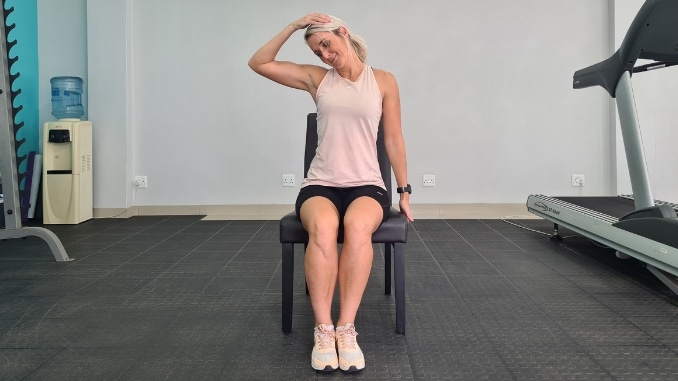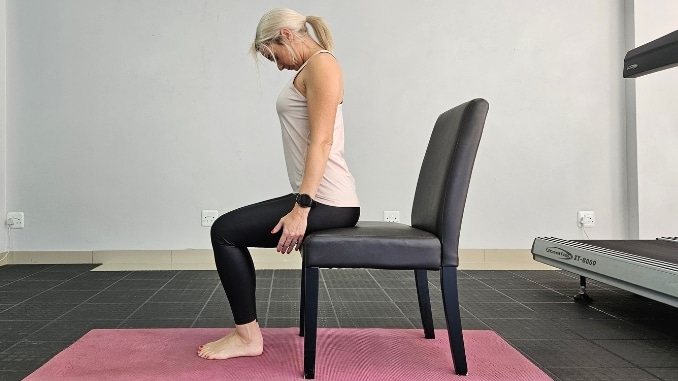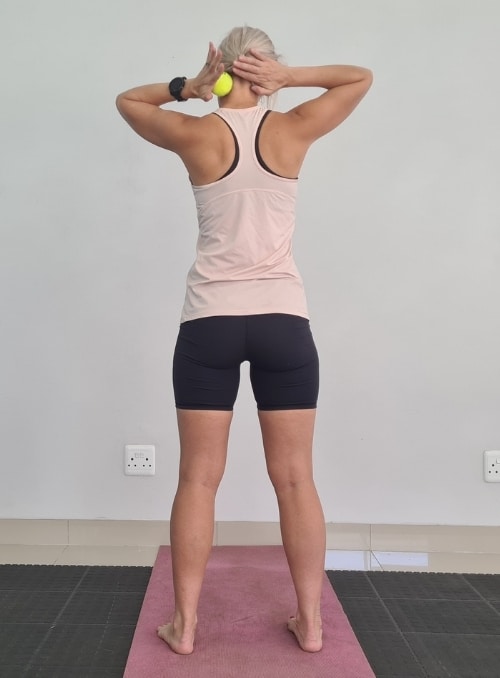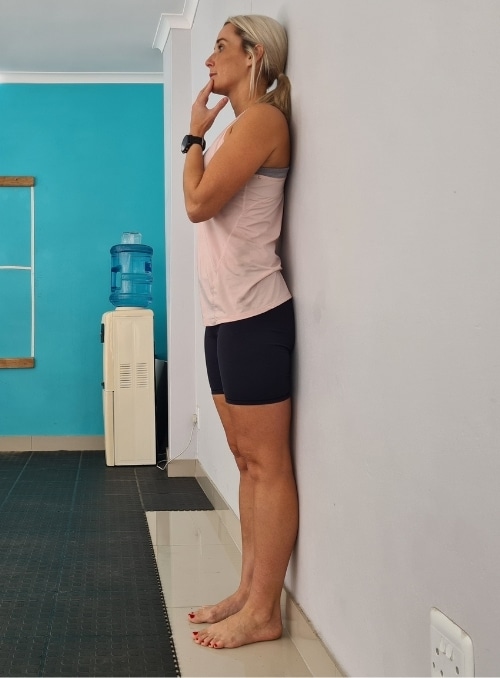What if the most overlooked part of your workout was the secret to ending stiff necks, headaches, and poor posture for good?
We’re gearing up to release something game-changing to help you move better and feel stronger.
While you wait, dive into this blog for expert tips and exercises to get a head start—because something big is coming soon.
With our detailed approach, you can avoid neck discomfort. Whether from screen time or poor posture, neck discomfort is common.
Master the art of neck strengthening through targeted exercises to relieve strain and enhance your neck and shoulder blades. Say goodbye to discomfort and hello to a stronger, more resilient neck.
Discover the power of at-home neck workouts with these simple yet effective exercises to strengthen neck muscles—no fancy equipment needed.
1. Side Neck Stretch

- Begin in an upright sitting position on a chair with your feet flat on the floor and knees together, while maintaining good alignment in your upper body.
- Place one hand on the side of the chair for support.
- Reach behind your back with one arm, then drop your opposite ear down towards your shoulder.
- Use your hand to gently pull your head closer to your shoulder.
- Hold the position for several deep belly breaths, in through your nose and out through your mouth.
- Relax and return to the starting position.
- Repeat the movement on the opposite side.
2. Chin to Chest Stretch

- For this exercise to strengthen neck muscles, begin in an upright sitting position on the edge of a chair with your feet flat on the floor and knees together, maintaining good alignment in your upper body.
- Place your hands at your sides.
- Engage your core and drop your head forward to lower your chin towards your chest.
- Hold the position for several deep belly breaths, in through your nose and out through your mouth.
3. Neck Rotation
- Begin in an upright sitting position on a chair with your feet flat on the floor and knees together, maintaining good alignment in your upper body.
- Place your hands on the sides of the chair for support.
- Tighten your core and turn your head to one side, ideally bringing your chin over your shoulder.
- Hold this position for several deep belly breaths, in through your nose and out through your mouth.
- Return to the starting position and repeat the movement on the opposite side.
4. Neck Circles

For this exercise to strengthen neck muscles, utilize the use of a tennis ball or a massage ball.
- Begin in an upright standing position with your feet hip-width apart, while maintaining good alignment of your head, shoulder, hips, and legs.
- Place your hands behind your head together with the ball.
- Engage your core and start by slowly tilting your head forward and gently rolling it to a counterclockwise direction.
- Return to the starting position and repeat the movement in a clockwise direction.
Note: Ensure smooth and controlled movements to avoid strain.
5. Shoulder Shrugs
- Begin in an upright sitting position with your feet flat on the floor and knees closed together.
- Maintaining good alignment of your upper body.
- Place both hands at your side.
- Engage your core.
- Shrug your shoulders towards your ears, lifting them as high as possible.
- Hold this position for several deep belly breaths, in through your nose and out through your mouth.
- Relax and slowly lower your shoulders. Repeat the movement.
6. Chin Tucks

- Begin in an upright standing position against the wall, while maintaining good alignment of your head, shoulder, hips, and legs.
- Place your one hand on your chin and pull your chin towards your chest without tilting your head.
- Hold this chin tucked position for several deep belly breaths, in through your nose and out through your mouth and return to the starting position.
- Repeat the movement.
7. Side-to-Side Head Movement
- For this exercise to strengthen neck muscles, begin in an upright sitting position with your feet flat on the floor and knees closed together.
- Maintaining good alignment of your upper body.
- Place your hands at your side.
- Engage your core.
- Slowly tilt your head to one side, bringing your ear towards your shoulder.
- Gently roll your head to the other side.
- Repeat this side-to-side movement for a fluid neck workout.
To elevate your routine, check these advanced exercises to strengthen neck muscles that you can seamlessly incorporate whenever you like, all within the comfort of your home.
According to Dr. Thomas Schuler, MD, you can effectively manage neck pain and improve function by committing to regular strengthening and conditioning exercises, flexibility routines, proper nutrition, and correct ergonomics. If you allow your muscles to become weak or imbalanced, or if you neglect consistent exercise, you’re more likely to experience pain and decreased performance.
Understanding Common Neck Muscle Problems
1. Text Neck
Excessive phone or computer use leads to neck pain, with symptoms like soreness, stiffness, and discomfort in the neck [3] and shoulders. Counteract these issues by incorporating neck and shoulder strengthening exercises to alleviate pain and enhance the resilience of your upper back muscles.
2. Stiff Neck
Avoid neck pain by maintaining a proper sleeping position to prevent stiffness and discomfort. Symptoms like tenderness, limited neck movement, and neck pain can arise [1] from lying at an awkward neck angle during sleep.
3. Muscle Strain

Neck pain from overuse or bad posture can be [2] debilitating. Experience aching or throbbing sensations, limited range of motion, and tenderness? Strengthen your neck with expert advice. Try the doorway chest stretch and other cervical spine exercises recommended by a physical therapist. Alleviate discomfort by squeezing shoulder blades and regain pain-free movement.
4. Stress Tension
Physical tension in the neck, a result of emotional stress, can cause discomfort and pain. Effectively managing stress is key to relieving this neck pain. Look out for symptoms such as a lingering headache and muscle tenderness in the neck and shoulder blades, signaling the need to address and strengthen your neck for relief.
5. Arthritis
As time passes, joint wear and tear can culminate in arthritis, causing stiffness and neck pain. Symptoms encompass chronic neck pain, stiffness, and swelling. To alleviate discomfort, especially with knees slightly bent for added support, consider incorporating targeted neck strengthening exercises. Focus on upper back muscles to promote resilience in the affected areas and enhance overall neck support.
6. Infections or Inflammation
Watch out for conditions like meningitis or inflamed lymph nodes, signaled by symptoms such as neck pain and stiffness. Don't ignore neck and shoulder pain, as it could be an early warning. Strengthen your neck and be proactive in addressing discomfort to prevent it from escalating into more severe issues.
Unraveling the Triggers and Causes of Neck and Shoulder Pain

Here are the following possible cause of neck pain:
- Poor Posture – Prolonged improper positioning and ergonomics can lead to various musculoskeletal issues, including strained neck and shoulders and pulling arms. This is because poor posture and repetitive movements can stress the muscles and tendons in these areas, causing them to become inflamed and irritated.
- Muscle Imbalance – Weakness due to imbalances in surrounding muscles affects neck stability.
- Inactivity- Neglecting regular exercise and specific arm and neck-strengthening routines can lead to muscle weakness.
- Aging – Natural decline in muscle mass and strength, making the back burn neck more receptive to weakness.
- Injury or Trauma – Previous incidents like whiplash or sports injuries can weaken and impact neck muscle function.
- Neck Strain – Overexertion or strain from constant neck movement or heavy lifting can cause muscle fatigue and weakness.
- Medical Conditions – Conditions like cervical disc herniation, spondylosis, or neurological disorders can affect neck muscle strength.
- Nerve Compression – Compression of cervical nerves disrupts signals to muscles, leading to weakness.
- Nutritional Deficiencies – Insufficient nutrient intake, especially for muscle health, contributes to muscle weakness.
Benefits of Neck Workouts at Home

Engaging in neck workouts at home offers numerous benefits for overall well-being.
- Neck Pain Relief: Strengthening neck muscles alleviates chronic discomfort from bad posture or muscle strain, promoting relief.
- Posture Enhancement: Neck exercises combat issues like forward head posture, contributing to improved overall posture.
- Flexibility Boost: Regular neck workouts increase the range of motion, reducing stiffness and enhancing flexibility.
- Headache Prevention: Strong neck and shoulder muscles lower muscle stress, promoting blood flow to the head and preventing tension headaches.
- Stress Reduction: Levator scapula stretch and neck exercises release tension in the neck and shoulder blades, fostering relaxation and stress reduction.
Why is it Important to Keep Your Neck Muscles Strong?

A robust neck provides head support, enhancing posture and reducing the risk of neck and shoulder issues. It acts as a stabilizer, preventing strain during movement and impact. A strong neck contributes to overall body strength, coordination, and flexibility, which is essential for activities like sports and driving.
A robust neck is vital for a healthy spine, maintaining alignment and reducing the risk of spinal disorders. Including neck-strengthening exercises in your routine enhances well-being, minimizing the chances of chronic neck pain or injury.
Ready to take the next step? Make your neck exercises even more effective with our upcoming Neck Aligner Tool, designed to improve posture, alignment, and muscle strength faster.
👉 Join the waitlist for early access. Be the first to try it!
Frequently Asked Questions
How often should you do neck-strengthening exercises?
To strengthen neck muscles, you should aim to do neck exercises 3–4 times per week for the best results. Consistency is key — regular training helps build endurance, flexibility, and strength in the muscles that support your head and spine. If you’re dealing with pain or recovering from an injury, consult a healthcare professional before starting a routine.
What’s the best time to do neck exercises — morning or evening?
You can do them at any time, but many people find morning exercises effective because they help release stiffness from sleeping positions. Evening sessions, on the other hand, are great for releasing tension built up from long hours of work or screen time. Choose the time that fits best with your routine — consistency matters more than timing.
Are neck exercises safe if you have existing neck pain?
In most cases, gentle neck exercises are safe and can even help reduce chronic pain — but it’s essential to start slowly and use correct form. If you have severe pain, numbness, or a diagnosed condition (like a herniated disc), check with a doctor or physical therapist before starting any new routine.





